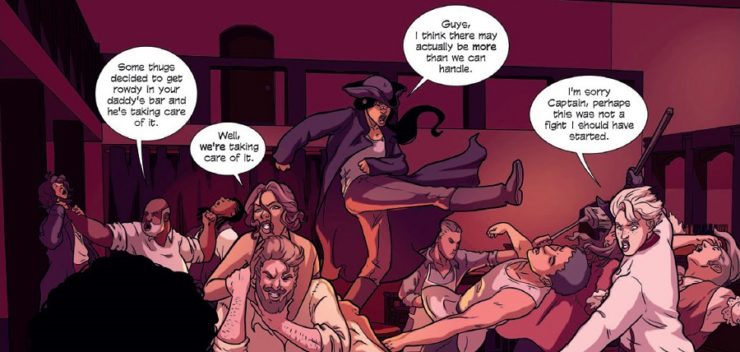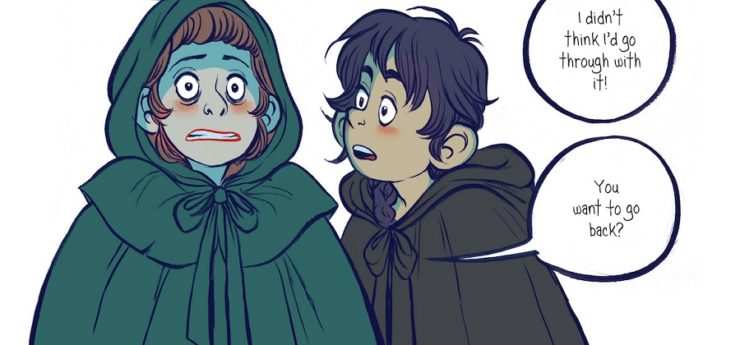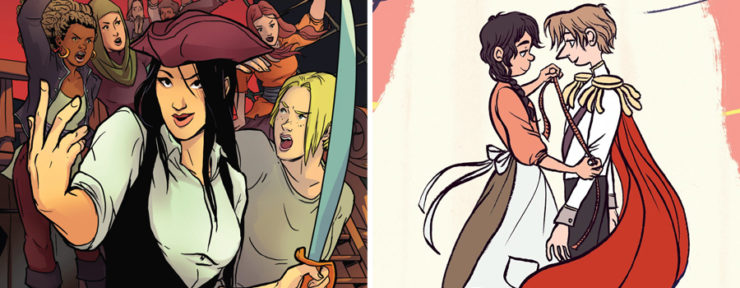I don’t know about you, but 2018 hasn’t exactly been a great year as far as I’m concerned. Is it better than the trashfire that was 2017? Only time will tell. But it’s only April and I’m already about done with everything. When I start to get all stressed out like this, the best way to calm me down is with a good book, or, in the case of this column, a good comic. So here are two tales about spunky royals and the unusual yet exciting circumstances they find themselves in. I give you the lovely, engaging, smile-inducing Princeless: Raven: The Pirate Princess and The Prince and the Dressmaker.
Princeless: Raven: the Pirate Princess

We first met Raven Xingtao in Princeless, but she’s had her own spinoff series since 2015. And what a great series it is! After being betrayed by her father and brothers who locked her in a tower, Raven finally escapes. At seventeen she has a ship, but no crew. Not until a chance encounter with half-elf and master pickpocket Sunshine, that is. Soon Raven is joined by an all-female (and mostly queer) crew, including her frenemy Sunshine, buff first mate Katie, and unrequited love Ximena. Raven and her pirate pals set out to take her inheritance back from her wicked brothers. Along the way they battle skeezy dudes, hungry alligators, and shady magical queens.
The diversity of Raven’s crew is one of the best parts about the series. In the back of one of the issues, writer Jeremy Whitley described why he went that route: “I wanted [Raven] to be surrounded by queer women of every shape, size, and ethnicity that identified as any number of things. In the crew we have characters who identify as lesbian, bisexual, demisexual, asexual, and even one dealing with questions about their gender. It was important that we represent a wide spectrum of women not just for the sake of representation…but to show that Raven and those around her have built a community for themselves where they’re among other queer women who accept their identities as they present them.” All of that comes across so well on the page. I went to an all-women’s college for undergrad, and didn’t realize how badly I needed that and how refreshing it was to have that experience until I was actually there. That’s how I felt about Raven. The stories are centered on women and women’s experiences, with men existing only on the periphery.
If it were just good at being women-centric, that’d be one thing. But every element of the series is fantastic. Whitley is a great comedic writer, but he deftly balances the jokes with heart and honesty. The art is solid across the board, but really soars with Christine Hipp at the helm and Xenia Pamfill supporting with colors. The pair absolutely nail the look of the book; between the two of them, it’s some of my favorite art I’ve seen in comics this year. Props also go to Justin Birch. Again, all the letterers have been strong, but Birch particularly good at keeping the flow of text natural and easy to read.
I hate that it took me three years to finally get around to reading this comic. It’s so good and here I’ve been wasting all this time not having this gem dramatically improving my life. I plowed through all nineteen issues in one night, I was so hooked. If this series is cancelled, I’ll be utterly devastated. You need to read this series.
Writer: Jeremy Whitley; art: Xenia Pamfil, Christine Hipp; pencils: Rosy Higgins, Sorah Suhng, Jason Strutz; inks: Ted Brandt, Nicki Andrews; layouts: Ted Brandt; colors: Rosy Higgins, William Blankenship, Ty Johnsen, Xenia Pamfil; letters: Ted Brandt, Dave Dwonch, Justin Birch. Action Comics released the most recent issue, #7 of Raven: Year 2, on April 18, 2018, and #8 is scheduled for May 23.
The Prince and the Dressmaker

Frances is a seamstress who longs to be a designer. When she’s offered a once-in-a-lifetime job working for the royal family, she leaps at the chance. She discovers she’s actually been hired by none other than Prince Sebastian, a young man looking for a confidante to help him explore his interest in wearing dresses. After Sebastian wins a best-dressed award during an exciting night on the town in one of Frances’ spectacular gowns, Lady Crystallia (his female alter ego) becomes the talk of the town. Sebastian struggles to maintain his secret identity all while his parents set him up with girl after girl, meanwhile Frances cannot tell anyone about her designs or risk outing her patron. As they navigate Parisian society, Sebastian and Frances struggle to be seen and accepted for who they truly are.
In a lot of ways, The Prince and the Dressmaker reminds me of Molly Ostertag’s delightful comic from last year, The Witch Boy. Both tell stories that can exist on a queer allegory spectrum without being explicitly queer. (And both are darn good stories, to boot!) Sebastian gives no indication he’s queer, even in coded historical terms, but from a contemporary perspective he’s clearly experimenting with gender expression and identity. And that’s what makes it so important for kids to read. They, like Sebastian, may not have the words or the concept of what they’re feeling; they may not even recognize that they are feeling anything. But fiction offers a lens with which to view ourselves. The Prince and the Dressmaker shows why Sebastian and Frances keep their secrets—for fear of the humiliation and rejection he later suffers—but, importantly, the acceptance they receive from those they care about the most. Frances and Sebastian hold their own personal truths from the world, and as much as it hurts when others betray them and reveal those truths without Frances or Sebastian’s consent, the acceptance they get in the end eases the pain. A story like this tells you that things can be different, that you don’t have to be what everyone says you are—a revolutionary idea for a lot of kids.
If I had to pick a quibble, it would be the lettering. Most of the time it’s fine, but more times than I’d like it was awkward or intrusive. I’m probably more sensitive to wonky lettering than the average reader as a side effect of writing about comics all the time, so if you don’t normally pick out lettering highs and lows then you probably won’t even notice it. The art is, of course, wonderful. Jen Wang has her own unique style that is as playful and emotive as her script. Wang is never better than when drawing Lady Crystallia and her fabulous outfits.
I read The Prince and the Dressmaker a few weeks ago and it still makes me happy just thinking about it. It’s an optimistic tale, full of hope and happy endings. Yet although it’s charming and sweet, it’s never twee. It’s like an exquisite dessert rather than cheap candy confections.
Story and art: Jen Wang. Published by First Second.
Alex Brown is a YA librarian by day, local historian by night, pop culture critic/reviewer by passion, and QWoC all the time. Keep up with her every move on Twitter, check out her endless barrage of cute rat pics on Instagram, or follow along with her reading adventures on her blog.










